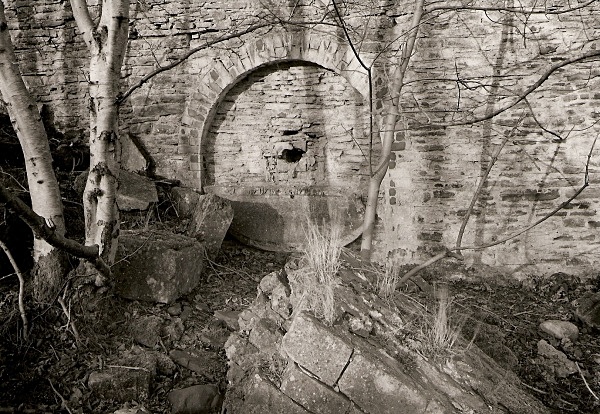Gellir lawrlwytho cynnwys at ddefnydd anfasnachol, megis defnydd personol neu ar gyfer adnoddau addysgol.
Ar gyfer defnydd masnachol cysyllwch yn uniongyrchol gyda deilydd yr hawlfraint os gwelwch yn dda.
Read more about the The Creative Archive Licence.
Disgrifiad
Notes on HAFOD (ruins, monuments and stables), Pontrhydygroes, Ceredigion 1996
My home territory – the house that stood was much older than its famous owner, Thomas Johnes, who inherited 1760.
One of the greatest monuments to the picturesque movement, Johnes created a paradise in the then wild and dangerous Cardiganshire by planting over 3 million hardwood trees (all but felled for the two great wars), folly’s, many miles of paths, a hermits cave, monuments, a robbers cave (a small walk down a cave turns a corner into a mass of sound as you stand confronted by a waterfall), many secret gardens and retreats.
The ruins came down in 1956. A pile of rubble remains. Hafod was painted by Turner, visited by George Burrows and inspired 'Peacocks in Paradise' by Elizabeth Eglais Jones. The famous monument by Chantrey in Hafod church survived the fire in 1932 but did not survive the fireman’s hose: the coolness of the water caused the hot stone of the monument to irreparably crack and crumble.
Much has been written about Hafod. I moved to one of the lodge houses in 1989 when I was 17 years old. At about the same time I purchased my first camera and began to document the landscape around me. I have chosen the landscape of Hafod many times but as unpredictable and beautiful as it is, it can be a frustrating photographic experience. For this I am partially thankful, since I live here I can appreciate the landscape and history without the worry that I have let myself down creatively.
YR HAFOD. Pontrhydygroes. Ceredigion 2000
Hwn yw fy nhiriogaeth i - roedd y ty a safai yno lawer yn hyn na'i berchennog enwog, Thomas Johnes. Creodd Johnes baradwys yn Sir Aberteifi drwy blannu mwy na 3 miliwn o goed pren caled (torrwyd y cyfan i lawr ar gyfer y ddau ryfel byd ). Fe wnaeth hynny mewn sir a oedd ar y pryd hwnnw'n wyllt a pheryglus. Hefyd adeiladwyd ffoieddau, milltiroedd o Iwybrau, ogof meudwy, henebion, ac ogof lladron ynghyd a nifer o erddi ac encilion cudd. Dymchwelwyd yr adfeilion yn 1956.






Oes gennych chi wybodaeth ychwanegol am yr eitem hon? Gadewch sylwad isod
Sylwadau (0)
Rhaid mewngofnodi i bostio sylw